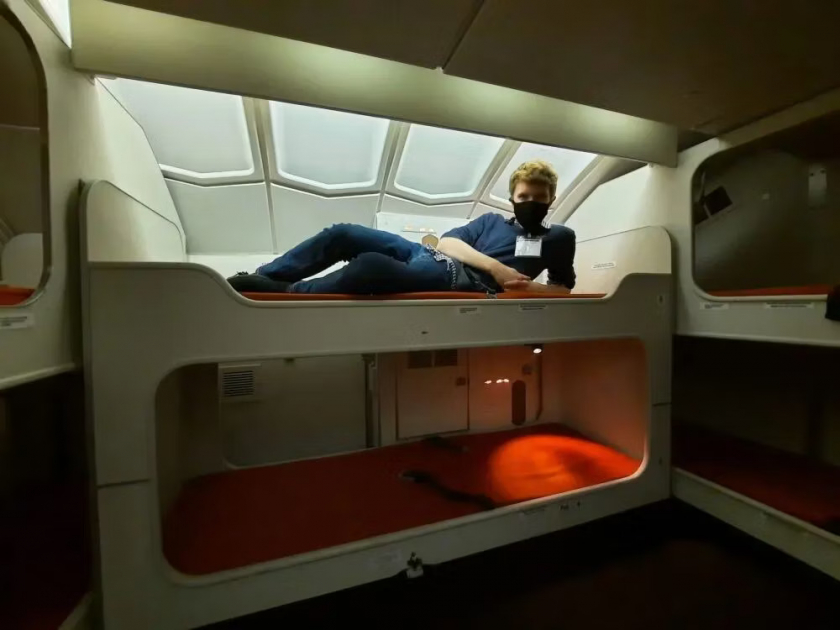On the plane there is always a resting space for the crew and this place is completely secret, not visible to passengers. On large, wide-body aircraft, the resting compartment for flight attendants and pilots is often designed behind locked doors and limited passenger access.
Inside the break room
Depending on the aircraft, these areas are usually located above or below the passenger cabin. Crew members often have to climb up or down to their sleeping areas to reach the small bunks.
The space of this accommodation is compared to a “capsule hotel” in Japan with characteristics such as: no windows, cramped but cozy area, with power outlets, night lights and intercom systems, oxygen masks, seat belts… The beds are divided by soundproof curtains to help block out light and noise, have reading lights, vents and entertainment systems to help crew members feel more comfortable…
“Sleeping in the cabins reserved for flight attendants is quite comfortable. However, for tall people, the space inside can be cramped compared to their body size. The bunk beds may be wider than sitting in first class, but depending on each person's needs, it becomes inconvenient or not, for example, stuffy, less legroom,” shared Susannah Carr, a flight attendant working for United Airlines (USA).

Sleeping cabins on large flights.
Delta Airlines of the US allowed reporters to access the restricted passenger area of the Airbus A350. The flight attendant bunks are located at the back of the plane, including one for the chief flight attendant. The pilot's rest area is at the front of the plane, with two bunks and a recliner. On older aircraft, their location may be in the cargo hold or in the main cabin.
Typically, airlines will commission the design of flight attendant rest areas from the manufacturer. The design must comply with specifications and standards set by regulatory agencies, such as the US Federal Aviation Administration. For example, sleeping areas usually have six or more beds, are located in a location that limits noise, odors, and vibrations to a moderate level. Temperature and lighting can be adjusted. Each room has a large mirror for flight attendants and pilots to adjust their uniforms, check their appearance, and be ready to return to work after a few hours of sleep.
The crew took turns resting.
Flight attendants and pilots take turns resting on intercontinental flights, which typically last 12 to 18 hours. After the main meal on a long-haul flight, half the flight attendants rest, while the other half continue working. The two groups alternate for half the flight. The pilots follow a similar schedule.
Most international airlines provide flight attendants with the same bedding amenities as business class. Delta's bunk beds come with Westin Heavenly bedding, while United Airlines's bedding is from Saks Fifth Avenue Polaris.

Resting place for airline staff on small routes.
On the Boeing 777, which can fly for 16 to 18 hours straight, the flight attendants' rest area is located above the economy cabin at the back of the plane. Passengers, of course, never know where this area is. On United's new Boeing 777-300ER, there are also two rest areas for flight attendants and pilots, at the back and front of the plane.
The appearance of this secret room does not attract much attention from passengers. Carr said that many people passing by think it is a wardrobe. In fact, behind the door is a staircase leading to the resting area, and the user needs a key or code to open it.
Crew privacy
On average, cabin crew on long-haul flights spend at least 10 percent of their flight time in the rest area. Karoliina Aman, a flight attendant for Finnair who works on Airbus A330s and A350s, estimates that she and her colleagues get about 1.5 hours of rest each night. However, the actual number can be several hours longer, depending on the airline and the actual flight time.
"Since the crew doesn't have any separate areas on the plane for lunch or breaks, this break is very important for me to stay alert. This is the only time during the flight when we don't have to answer passenger calls or do any other tasks," Aman said. During this rest time, flight attendants can sleep or read books, watch movies, or use their phones.

Private space for crew.
The "secret compartment" is closed during take-off and landing and is used in shifts, under the supervision and division of the chief flight attendant. The flight crew will split into two to take turns serving and resting.
In addition, pilots often have their own sleeping quarters above the cockpit, separate from the flight attendants' quarters. Depending on the duration of the flight, each plane can have up to four pilots. Due to the regulation that there must always be two pilots in the cockpit, the pilot's sleeping quarters usually have only two beds, or even just one on older planes, and a recliner. On larger planes like the Boeing 777, pilots have their own, more spacious sleeping quarters, with two business class seats, a wardrobe, a sink or toilet, and an entertainment system.
“I usually sleep very well in the cockpit,” says Aleksi Kuosmanen, deputy chief pilot at Finnair. “You can adjust the temperature to your comfort, the ventilation is great and the soundproofing is better. You don’t hear any noise from the cabin, it’s really quiet and comfortable.”


































